Leadership for Beginning Practice: Gibbs Reflective Cycle Analysis
VerifiedAdded on 2022/10/10
|9
|3047
|20
Essay
AI Summary
This essay examines leadership within a nursing context, focusing on a case study involving a Nursing Unit Manager (NUM) and a nurse named Kim, analyzing their interactions during an intubation procedure. The essay utilizes the Gibbs Reflective Cycle to dissect the situation, evaluating the behaviors of the NUM and the registrar, and their impact on Kim. It explores the importance of communication skills, respect, and emotional intelligence in leadership, and how the actions of the NUM and registrar fell short of these standards. The author reflects on their own leadership strengths and weaknesses, conducting a SWOT analysis to assess their potential in future nursing roles. The essay concludes with an action plan, suggesting training and team-building activities to foster a more supportive and professional work environment, emphasizing the critical role of leadership in healthcare settings and the need for respectful interactions to ensure patient care and staff well-being. The essay highlights the importance of mental resilience and proper communication, and provides practical suggestions for improving leadership practices in the healthcare setting.
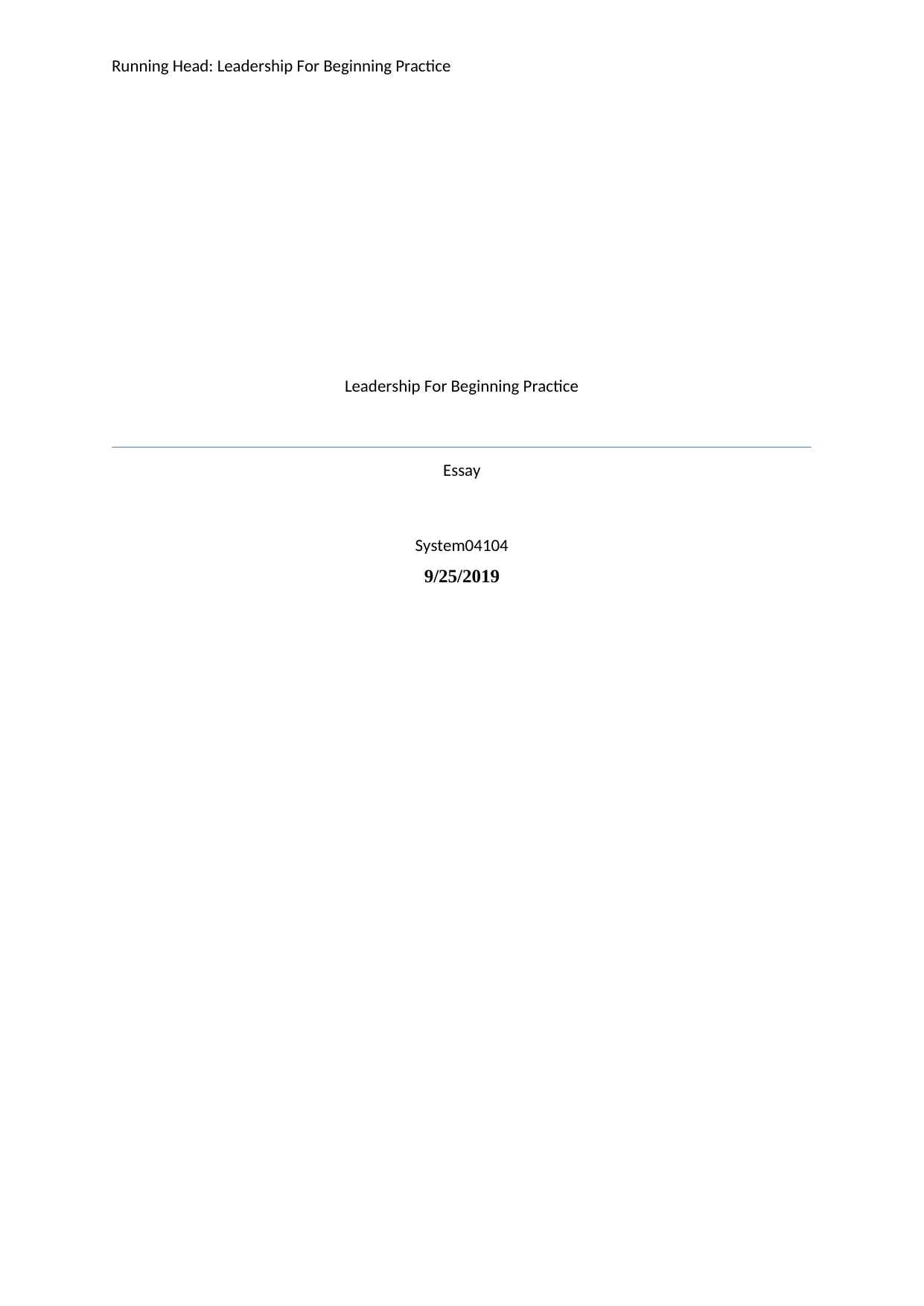
Running Head: Leadership For Beginning Practice
Leadership For Beginning Practice
Essay
System04104
9/25/2019
Leadership For Beginning Practice
Essay
System04104
9/25/2019
Paraphrase This Document
Need a fresh take? Get an instant paraphrase of this document with our AI Paraphraser
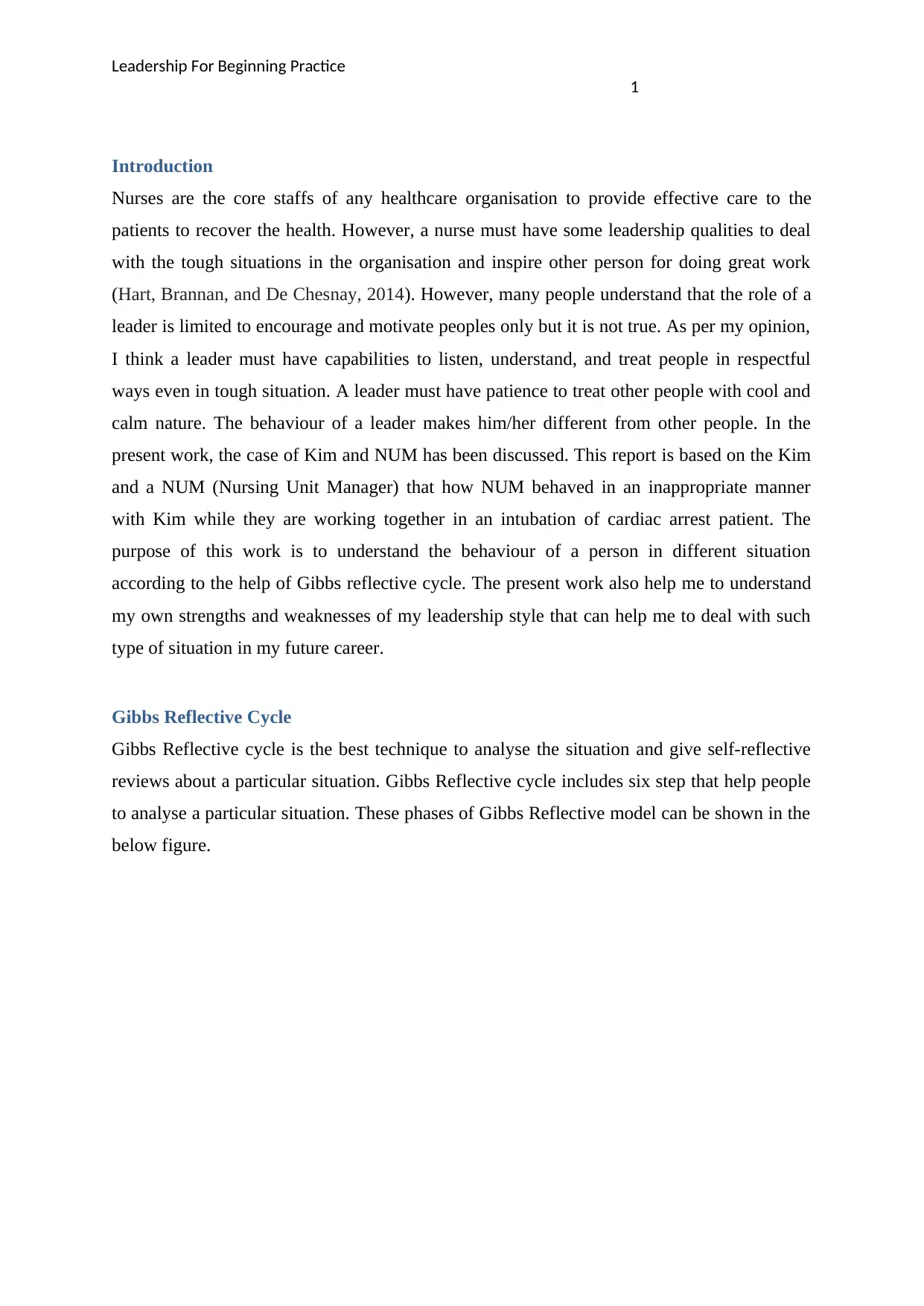
Leadership For Beginning Practice
1
Introduction
Nurses are the core staffs of any healthcare organisation to provide effective care to the
patients to recover the health. However, a nurse must have some leadership qualities to deal
with the tough situations in the organisation and inspire other person for doing great work
(Hart, Brannan, and De Chesnay, 2014). However, many people understand that the role of a
leader is limited to encourage and motivate peoples only but it is not true. As per my opinion,
I think a leader must have capabilities to listen, understand, and treat people in respectful
ways even in tough situation. A leader must have patience to treat other people with cool and
calm nature. The behaviour of a leader makes him/her different from other people. In the
present work, the case of Kim and NUM has been discussed. This report is based on the Kim
and a NUM (Nursing Unit Manager) that how NUM behaved in an inappropriate manner
with Kim while they are working together in an intubation of cardiac arrest patient. The
purpose of this work is to understand the behaviour of a person in different situation
according to the help of Gibbs reflective cycle. The present work also help me to understand
my own strengths and weaknesses of my leadership style that can help me to deal with such
type of situation in my future career.
Gibbs Reflective Cycle
Gibbs Reflective cycle is the best technique to analyse the situation and give self-reflective
reviews about a particular situation. Gibbs Reflective cycle includes six step that help people
to analyse a particular situation. These phases of Gibbs Reflective model can be shown in the
below figure.
1
Introduction
Nurses are the core staffs of any healthcare organisation to provide effective care to the
patients to recover the health. However, a nurse must have some leadership qualities to deal
with the tough situations in the organisation and inspire other person for doing great work
(Hart, Brannan, and De Chesnay, 2014). However, many people understand that the role of a
leader is limited to encourage and motivate peoples only but it is not true. As per my opinion,
I think a leader must have capabilities to listen, understand, and treat people in respectful
ways even in tough situation. A leader must have patience to treat other people with cool and
calm nature. The behaviour of a leader makes him/her different from other people. In the
present work, the case of Kim and NUM has been discussed. This report is based on the Kim
and a NUM (Nursing Unit Manager) that how NUM behaved in an inappropriate manner
with Kim while they are working together in an intubation of cardiac arrest patient. The
purpose of this work is to understand the behaviour of a person in different situation
according to the help of Gibbs reflective cycle. The present work also help me to understand
my own strengths and weaknesses of my leadership style that can help me to deal with such
type of situation in my future career.
Gibbs Reflective Cycle
Gibbs Reflective cycle is the best technique to analyse the situation and give self-reflective
reviews about a particular situation. Gibbs Reflective cycle includes six step that help people
to analyse a particular situation. These phases of Gibbs Reflective model can be shown in the
below figure.
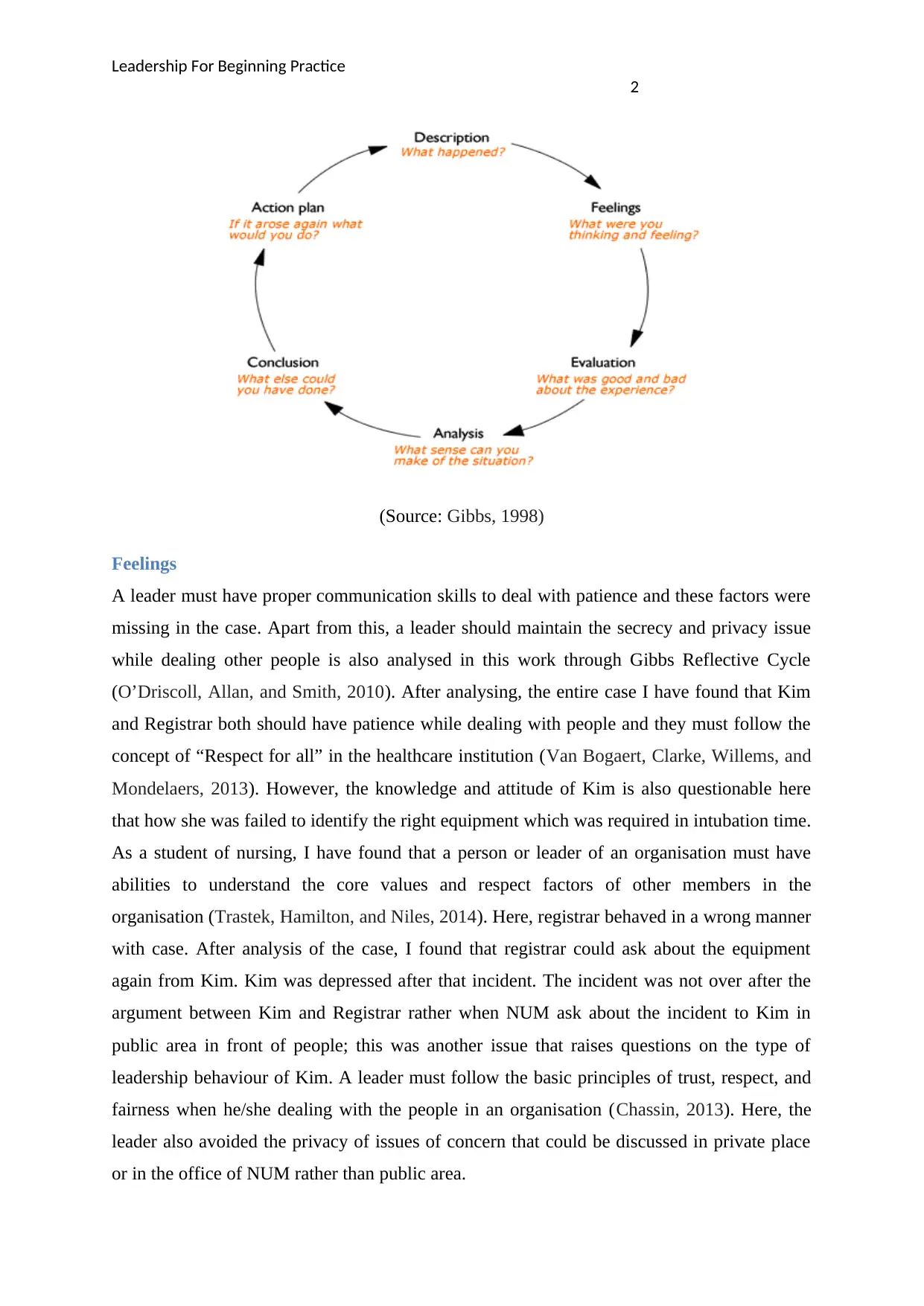
Leadership For Beginning Practice
2
(Source: Gibbs, 1998)
Feelings
A leader must have proper communication skills to deal with patience and these factors were
missing in the case. Apart from this, a leader should maintain the secrecy and privacy issue
while dealing other people is also analysed in this work through Gibbs Reflective Cycle
(O’Driscoll, Allan, and Smith, 2010). After analysing, the entire case I have found that Kim
and Registrar both should have patience while dealing with people and they must follow the
concept of “Respect for all” in the healthcare institution (Van Bogaert, Clarke, Willems, and
Mondelaers, 2013). However, the knowledge and attitude of Kim is also questionable here
that how she was failed to identify the right equipment which was required in intubation time.
As a student of nursing, I have found that a person or leader of an organisation must have
abilities to understand the core values and respect factors of other members in the
organisation (Trastek, Hamilton, and Niles, 2014). Here, registrar behaved in a wrong manner
with case. After analysis of the case, I found that registrar could ask about the equipment
again from Kim. Kim was depressed after that incident. The incident was not over after the
argument between Kim and Registrar rather when NUM ask about the incident to Kim in
public area in front of people; this was another issue that raises questions on the type of
leadership behaviour of Kim. A leader must follow the basic principles of trust, respect, and
fairness when he/she dealing with the people in an organisation (Chassin, 2013). Here, the
leader also avoided the privacy of issues of concern that could be discussed in private place
or in the office of NUM rather than public area.
2
(Source: Gibbs, 1998)
Feelings
A leader must have proper communication skills to deal with patience and these factors were
missing in the case. Apart from this, a leader should maintain the secrecy and privacy issue
while dealing other people is also analysed in this work through Gibbs Reflective Cycle
(O’Driscoll, Allan, and Smith, 2010). After analysing, the entire case I have found that Kim
and Registrar both should have patience while dealing with people and they must follow the
concept of “Respect for all” in the healthcare institution (Van Bogaert, Clarke, Willems, and
Mondelaers, 2013). However, the knowledge and attitude of Kim is also questionable here
that how she was failed to identify the right equipment which was required in intubation time.
As a student of nursing, I have found that a person or leader of an organisation must have
abilities to understand the core values and respect factors of other members in the
organisation (Trastek, Hamilton, and Niles, 2014). Here, registrar behaved in a wrong manner
with case. After analysis of the case, I found that registrar could ask about the equipment
again from Kim. Kim was depressed after that incident. The incident was not over after the
argument between Kim and Registrar rather when NUM ask about the incident to Kim in
public area in front of people; this was another issue that raises questions on the type of
leadership behaviour of Kim. A leader must follow the basic principles of trust, respect, and
fairness when he/she dealing with the people in an organisation (Chassin, 2013). Here, the
leader also avoided the privacy of issues of concern that could be discussed in private place
or in the office of NUM rather than public area.
⊘ This is a preview!⊘
Do you want full access?
Subscribe today to unlock all pages.

Trusted by 1+ million students worldwide
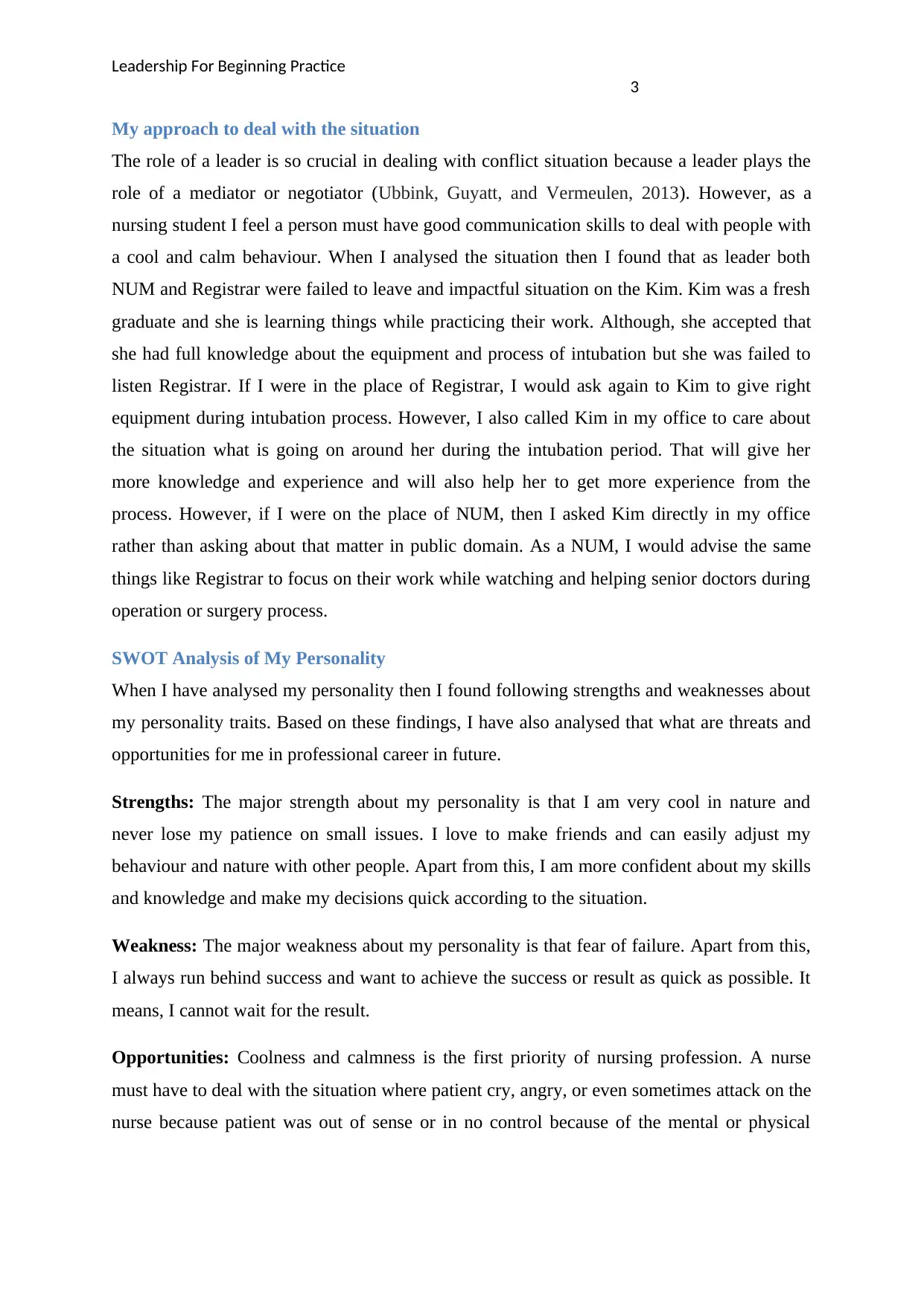
Leadership For Beginning Practice
3
My approach to deal with the situation
The role of a leader is so crucial in dealing with conflict situation because a leader plays the
role of a mediator or negotiator (Ubbink, Guyatt, and Vermeulen, 2013). However, as a
nursing student I feel a person must have good communication skills to deal with people with
a cool and calm behaviour. When I analysed the situation then I found that as leader both
NUM and Registrar were failed to leave and impactful situation on the Kim. Kim was a fresh
graduate and she is learning things while practicing their work. Although, she accepted that
she had full knowledge about the equipment and process of intubation but she was failed to
listen Registrar. If I were in the place of Registrar, I would ask again to Kim to give right
equipment during intubation process. However, I also called Kim in my office to care about
the situation what is going on around her during the intubation period. That will give her
more knowledge and experience and will also help her to get more experience from the
process. However, if I were on the place of NUM, then I asked Kim directly in my office
rather than asking about that matter in public domain. As a NUM, I would advise the same
things like Registrar to focus on their work while watching and helping senior doctors during
operation or surgery process.
SWOT Analysis of My Personality
When I have analysed my personality then I found following strengths and weaknesses about
my personality traits. Based on these findings, I have also analysed that what are threats and
opportunities for me in professional career in future.
Strengths: The major strength about my personality is that I am very cool in nature and
never lose my patience on small issues. I love to make friends and can easily adjust my
behaviour and nature with other people. Apart from this, I am more confident about my skills
and knowledge and make my decisions quick according to the situation.
Weakness: The major weakness about my personality is that fear of failure. Apart from this,
I always run behind success and want to achieve the success or result as quick as possible. It
means, I cannot wait for the result.
Opportunities: Coolness and calmness is the first priority of nursing profession. A nurse
must have to deal with the situation where patient cry, angry, or even sometimes attack on the
nurse because patient was out of sense or in no control because of the mental or physical
3
My approach to deal with the situation
The role of a leader is so crucial in dealing with conflict situation because a leader plays the
role of a mediator or negotiator (Ubbink, Guyatt, and Vermeulen, 2013). However, as a
nursing student I feel a person must have good communication skills to deal with people with
a cool and calm behaviour. When I analysed the situation then I found that as leader both
NUM and Registrar were failed to leave and impactful situation on the Kim. Kim was a fresh
graduate and she is learning things while practicing their work. Although, she accepted that
she had full knowledge about the equipment and process of intubation but she was failed to
listen Registrar. If I were in the place of Registrar, I would ask again to Kim to give right
equipment during intubation process. However, I also called Kim in my office to care about
the situation what is going on around her during the intubation period. That will give her
more knowledge and experience and will also help her to get more experience from the
process. However, if I were on the place of NUM, then I asked Kim directly in my office
rather than asking about that matter in public domain. As a NUM, I would advise the same
things like Registrar to focus on their work while watching and helping senior doctors during
operation or surgery process.
SWOT Analysis of My Personality
When I have analysed my personality then I found following strengths and weaknesses about
my personality traits. Based on these findings, I have also analysed that what are threats and
opportunities for me in professional career in future.
Strengths: The major strength about my personality is that I am very cool in nature and
never lose my patience on small issues. I love to make friends and can easily adjust my
behaviour and nature with other people. Apart from this, I am more confident about my skills
and knowledge and make my decisions quick according to the situation.
Weakness: The major weakness about my personality is that fear of failure. Apart from this,
I always run behind success and want to achieve the success or result as quick as possible. It
means, I cannot wait for the result.
Opportunities: Coolness and calmness is the first priority of nursing profession. A nurse
must have to deal with the situation where patient cry, angry, or even sometimes attack on the
nurse because patient was out of sense or in no control because of the mental or physical
Paraphrase This Document
Need a fresh take? Get an instant paraphrase of this document with our AI Paraphraser
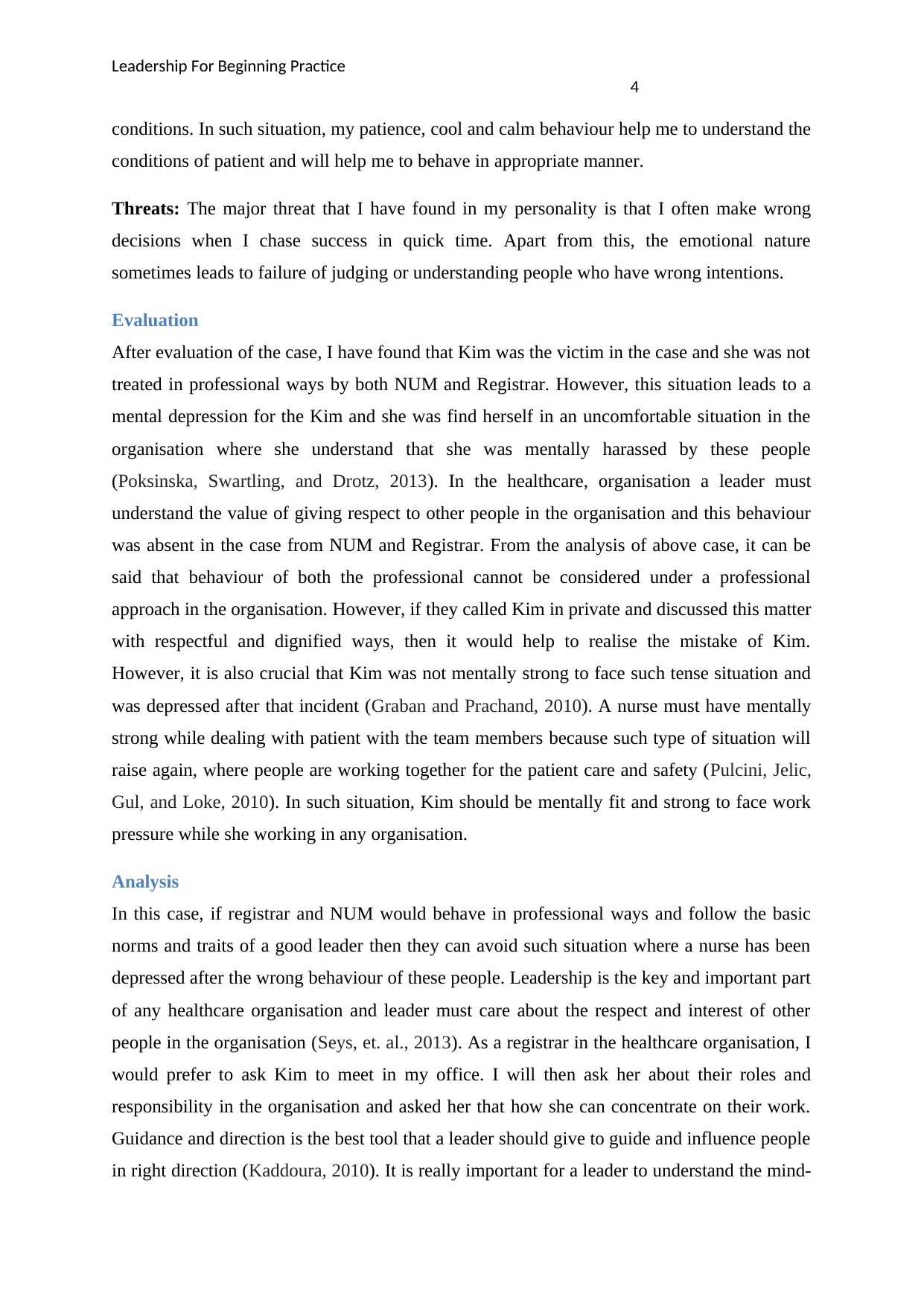
Leadership For Beginning Practice
4
conditions. In such situation, my patience, cool and calm behaviour help me to understand the
conditions of patient and will help me to behave in appropriate manner.
Threats: The major threat that I have found in my personality is that I often make wrong
decisions when I chase success in quick time. Apart from this, the emotional nature
sometimes leads to failure of judging or understanding people who have wrong intentions.
Evaluation
After evaluation of the case, I have found that Kim was the victim in the case and she was not
treated in professional ways by both NUM and Registrar. However, this situation leads to a
mental depression for the Kim and she was find herself in an uncomfortable situation in the
organisation where she understand that she was mentally harassed by these people
(Poksinska, Swartling, and Drotz, 2013). In the healthcare, organisation a leader must
understand the value of giving respect to other people in the organisation and this behaviour
was absent in the case from NUM and Registrar. From the analysis of above case, it can be
said that behaviour of both the professional cannot be considered under a professional
approach in the organisation. However, if they called Kim in private and discussed this matter
with respectful and dignified ways, then it would help to realise the mistake of Kim.
However, it is also crucial that Kim was not mentally strong to face such tense situation and
was depressed after that incident (Graban and Prachand, 2010). A nurse must have mentally
strong while dealing with patient with the team members because such type of situation will
raise again, where people are working together for the patient care and safety (Pulcini, Jelic,
Gul, and Loke, 2010). In such situation, Kim should be mentally fit and strong to face work
pressure while she working in any organisation.
Analysis
In this case, if registrar and NUM would behave in professional ways and follow the basic
norms and traits of a good leader then they can avoid such situation where a nurse has been
depressed after the wrong behaviour of these people. Leadership is the key and important part
of any healthcare organisation and leader must care about the respect and interest of other
people in the organisation (Seys, et. al., 2013). As a registrar in the healthcare organisation, I
would prefer to ask Kim to meet in my office. I will then ask her about their roles and
responsibility in the organisation and asked her that how she can concentrate on their work.
Guidance and direction is the best tool that a leader should give to guide and influence people
in right direction (Kaddoura, 2010). It is really important for a leader to understand the mind-
4
conditions. In such situation, my patience, cool and calm behaviour help me to understand the
conditions of patient and will help me to behave in appropriate manner.
Threats: The major threat that I have found in my personality is that I often make wrong
decisions when I chase success in quick time. Apart from this, the emotional nature
sometimes leads to failure of judging or understanding people who have wrong intentions.
Evaluation
After evaluation of the case, I have found that Kim was the victim in the case and she was not
treated in professional ways by both NUM and Registrar. However, this situation leads to a
mental depression for the Kim and she was find herself in an uncomfortable situation in the
organisation where she understand that she was mentally harassed by these people
(Poksinska, Swartling, and Drotz, 2013). In the healthcare, organisation a leader must
understand the value of giving respect to other people in the organisation and this behaviour
was absent in the case from NUM and Registrar. From the analysis of above case, it can be
said that behaviour of both the professional cannot be considered under a professional
approach in the organisation. However, if they called Kim in private and discussed this matter
with respectful and dignified ways, then it would help to realise the mistake of Kim.
However, it is also crucial that Kim was not mentally strong to face such tense situation and
was depressed after that incident (Graban and Prachand, 2010). A nurse must have mentally
strong while dealing with patient with the team members because such type of situation will
raise again, where people are working together for the patient care and safety (Pulcini, Jelic,
Gul, and Loke, 2010). In such situation, Kim should be mentally fit and strong to face work
pressure while she working in any organisation.
Analysis
In this case, if registrar and NUM would behave in professional ways and follow the basic
norms and traits of a good leader then they can avoid such situation where a nurse has been
depressed after the wrong behaviour of these people. Leadership is the key and important part
of any healthcare organisation and leader must care about the respect and interest of other
people in the organisation (Seys, et. al., 2013). As a registrar in the healthcare organisation, I
would prefer to ask Kim to meet in my office. I will then ask her about their roles and
responsibility in the organisation and asked her that how she can concentrate on their work.
Guidance and direction is the best tool that a leader should give to guide and influence people
in right direction (Kaddoura, 2010). It is really important for a leader to understand the mind-
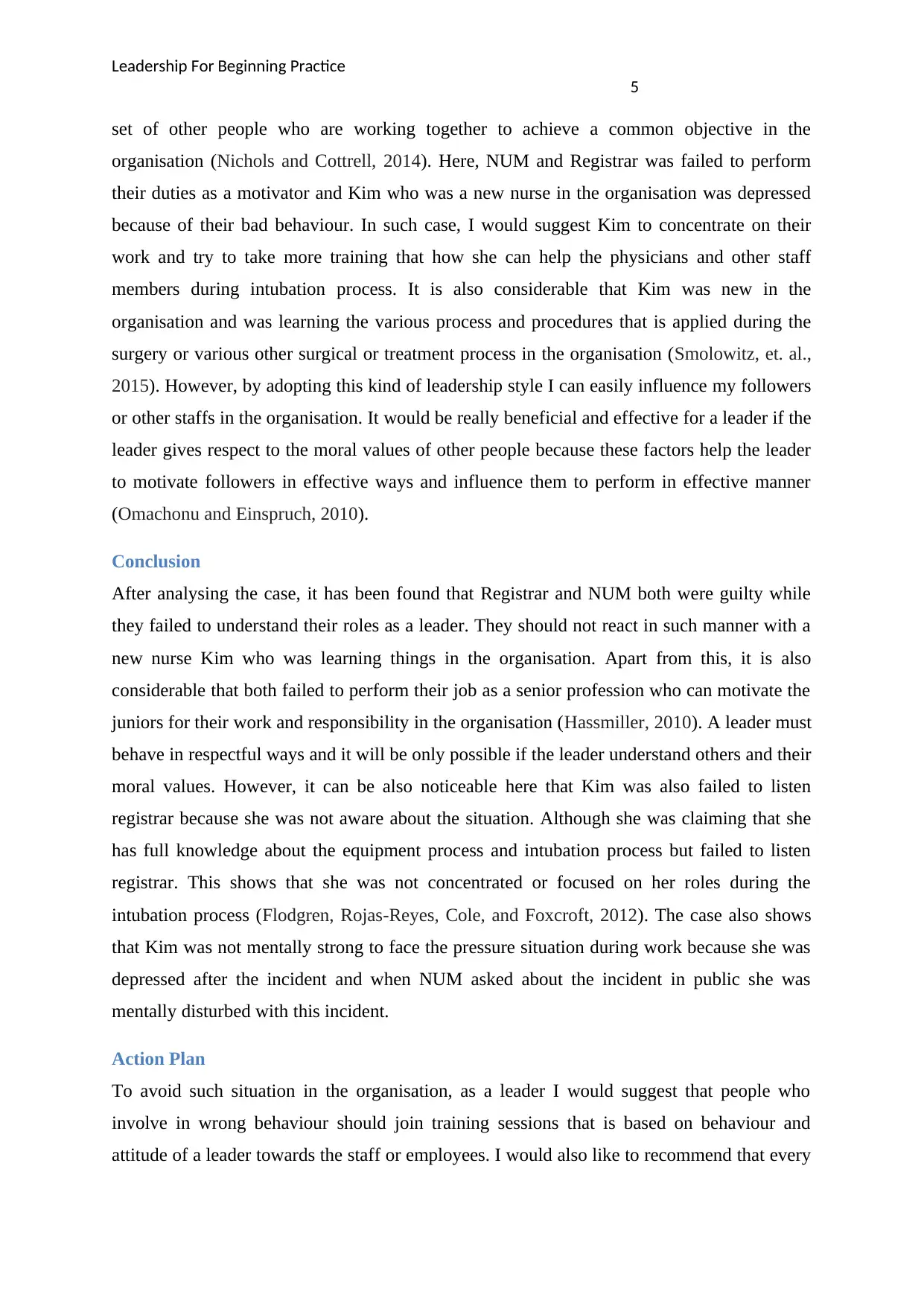
Leadership For Beginning Practice
5
set of other people who are working together to achieve a common objective in the
organisation (Nichols and Cottrell, 2014). Here, NUM and Registrar was failed to perform
their duties as a motivator and Kim who was a new nurse in the organisation was depressed
because of their bad behaviour. In such case, I would suggest Kim to concentrate on their
work and try to take more training that how she can help the physicians and other staff
members during intubation process. It is also considerable that Kim was new in the
organisation and was learning the various process and procedures that is applied during the
surgery or various other surgical or treatment process in the organisation (Smolowitz, et. al.,
2015). However, by adopting this kind of leadership style I can easily influence my followers
or other staffs in the organisation. It would be really beneficial and effective for a leader if the
leader gives respect to the moral values of other people because these factors help the leader
to motivate followers in effective ways and influence them to perform in effective manner
(Omachonu and Einspruch, 2010).
Conclusion
After analysing the case, it has been found that Registrar and NUM both were guilty while
they failed to understand their roles as a leader. They should not react in such manner with a
new nurse Kim who was learning things in the organisation. Apart from this, it is also
considerable that both failed to perform their job as a senior profession who can motivate the
juniors for their work and responsibility in the organisation (Hassmiller, 2010). A leader must
behave in respectful ways and it will be only possible if the leader understand others and their
moral values. However, it can be also noticeable here that Kim was also failed to listen
registrar because she was not aware about the situation. Although she was claiming that she
has full knowledge about the equipment process and intubation process but failed to listen
registrar. This shows that she was not concentrated or focused on her roles during the
intubation process (Flodgren, Rojas‐Reyes, Cole, and Foxcroft, 2012). The case also shows
that Kim was not mentally strong to face the pressure situation during work because she was
depressed after the incident and when NUM asked about the incident in public she was
mentally disturbed with this incident.
Action Plan
To avoid such situation in the organisation, as a leader I would suggest that people who
involve in wrong behaviour should join training sessions that is based on behaviour and
attitude of a leader towards the staff or employees. I would also like to recommend that every
5
set of other people who are working together to achieve a common objective in the
organisation (Nichols and Cottrell, 2014). Here, NUM and Registrar was failed to perform
their duties as a motivator and Kim who was a new nurse in the organisation was depressed
because of their bad behaviour. In such case, I would suggest Kim to concentrate on their
work and try to take more training that how she can help the physicians and other staff
members during intubation process. It is also considerable that Kim was new in the
organisation and was learning the various process and procedures that is applied during the
surgery or various other surgical or treatment process in the organisation (Smolowitz, et. al.,
2015). However, by adopting this kind of leadership style I can easily influence my followers
or other staffs in the organisation. It would be really beneficial and effective for a leader if the
leader gives respect to the moral values of other people because these factors help the leader
to motivate followers in effective ways and influence them to perform in effective manner
(Omachonu and Einspruch, 2010).
Conclusion
After analysing the case, it has been found that Registrar and NUM both were guilty while
they failed to understand their roles as a leader. They should not react in such manner with a
new nurse Kim who was learning things in the organisation. Apart from this, it is also
considerable that both failed to perform their job as a senior profession who can motivate the
juniors for their work and responsibility in the organisation (Hassmiller, 2010). A leader must
behave in respectful ways and it will be only possible if the leader understand others and their
moral values. However, it can be also noticeable here that Kim was also failed to listen
registrar because she was not aware about the situation. Although she was claiming that she
has full knowledge about the equipment process and intubation process but failed to listen
registrar. This shows that she was not concentrated or focused on her roles during the
intubation process (Flodgren, Rojas‐Reyes, Cole, and Foxcroft, 2012). The case also shows
that Kim was not mentally strong to face the pressure situation during work because she was
depressed after the incident and when NUM asked about the incident in public she was
mentally disturbed with this incident.
Action Plan
To avoid such situation in the organisation, as a leader I would suggest that people who
involve in wrong behaviour should join training sessions that is based on behaviour and
attitude of a leader towards the staff or employees. I would also like to recommend that every
⊘ This is a preview!⊘
Do you want full access?
Subscribe today to unlock all pages.

Trusted by 1+ million students worldwide
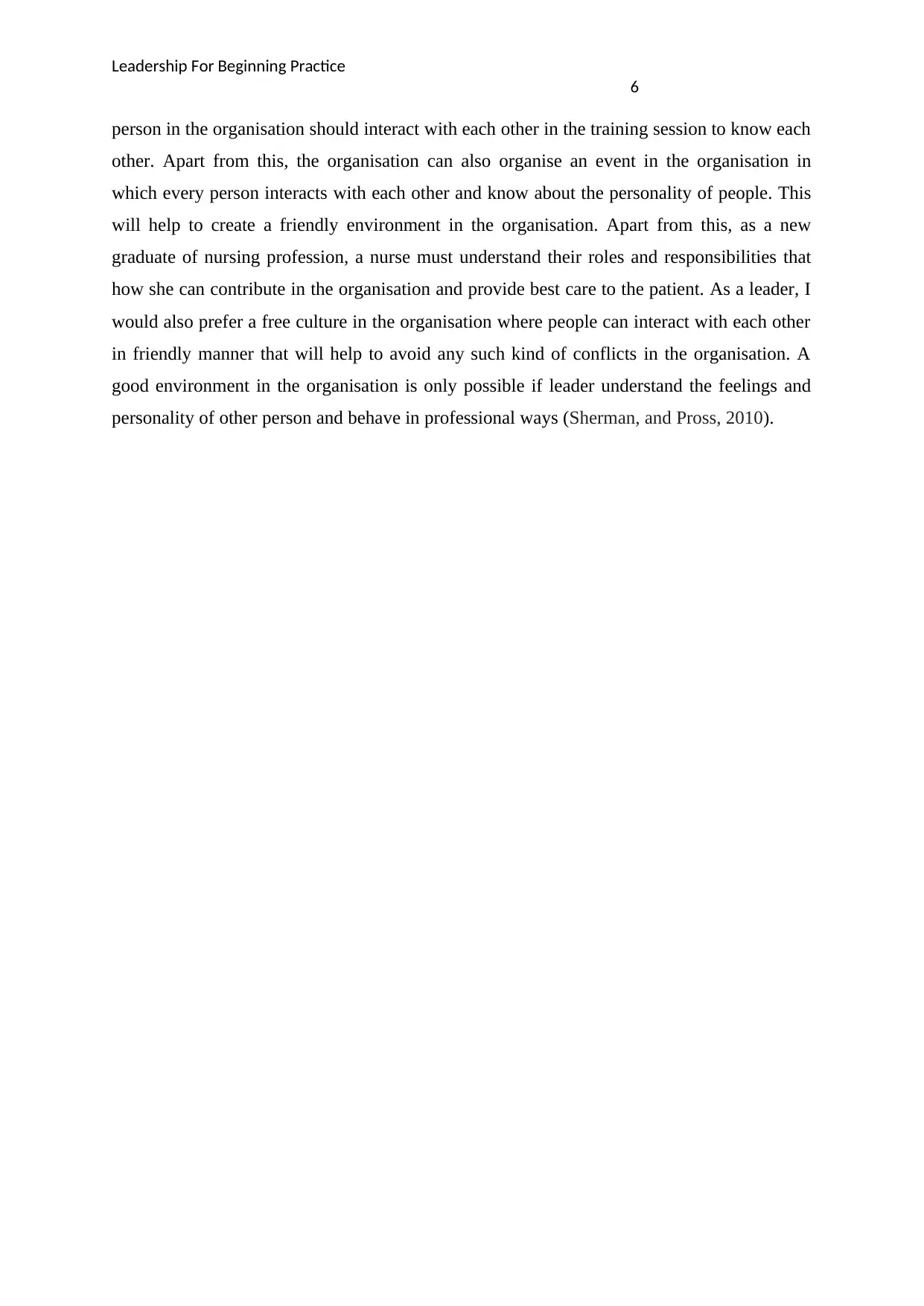
Leadership For Beginning Practice
6
person in the organisation should interact with each other in the training session to know each
other. Apart from this, the organisation can also organise an event in the organisation in
which every person interacts with each other and know about the personality of people. This
will help to create a friendly environment in the organisation. Apart from this, as a new
graduate of nursing profession, a nurse must understand their roles and responsibilities that
how she can contribute in the organisation and provide best care to the patient. As a leader, I
would also prefer a free culture in the organisation where people can interact with each other
in friendly manner that will help to avoid any such kind of conflicts in the organisation. A
good environment in the organisation is only possible if leader understand the feelings and
personality of other person and behave in professional ways (Sherman, and Pross, 2010).
6
person in the organisation should interact with each other in the training session to know each
other. Apart from this, the organisation can also organise an event in the organisation in
which every person interacts with each other and know about the personality of people. This
will help to create a friendly environment in the organisation. Apart from this, as a new
graduate of nursing profession, a nurse must understand their roles and responsibilities that
how she can contribute in the organisation and provide best care to the patient. As a leader, I
would also prefer a free culture in the organisation where people can interact with each other
in friendly manner that will help to avoid any such kind of conflicts in the organisation. A
good environment in the organisation is only possible if leader understand the feelings and
personality of other person and behave in professional ways (Sherman, and Pross, 2010).
Paraphrase This Document
Need a fresh take? Get an instant paraphrase of this document with our AI Paraphraser
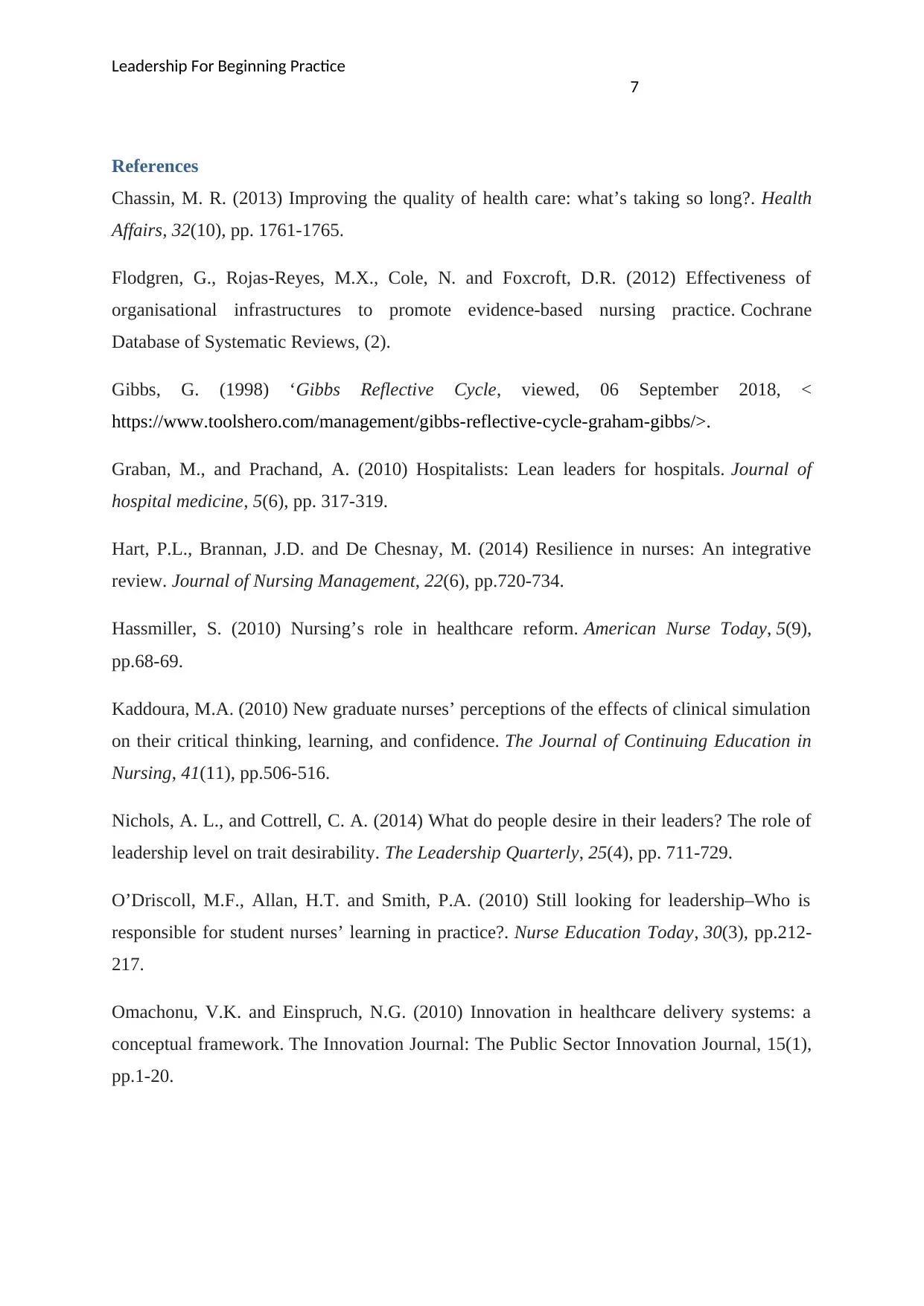
Leadership For Beginning Practice
7
References
Chassin, M. R. (2013) Improving the quality of health care: what’s taking so long?. Health
Affairs, 32(10), pp. 1761-1765.
Flodgren, G., Rojas‐Reyes, M.X., Cole, N. and Foxcroft, D.R. (2012) Effectiveness of
organisational infrastructures to promote evidence‐based nursing practice. Cochrane
Database of Systematic Reviews, (2).
Gibbs, G. (1998) ‘Gibbs Reflective Cycle, viewed, 06 September 2018, <
https://www.toolshero.com/management/gibbs-reflective-cycle-graham-gibbs/>.
Graban, M., and Prachand, A. (2010) Hospitalists: Lean leaders for hospitals. Journal of
hospital medicine, 5(6), pp. 317-319.
Hart, P.L., Brannan, J.D. and De Chesnay, M. (2014) Resilience in nurses: An integrative
review. Journal of Nursing Management, 22(6), pp.720-734.
Hassmiller, S. (2010) Nursing’s role in healthcare reform. American Nurse Today, 5(9),
pp.68-69.
Kaddoura, M.A. (2010) New graduate nurses’ perceptions of the effects of clinical simulation
on their critical thinking, learning, and confidence. The Journal of Continuing Education in
Nursing, 41(11), pp.506-516.
Nichols, A. L., and Cottrell, C. A. (2014) What do people desire in their leaders? The role of
leadership level on trait desirability. The Leadership Quarterly, 25(4), pp. 711-729.
O’Driscoll, M.F., Allan, H.T. and Smith, P.A. (2010) Still looking for leadership–Who is
responsible for student nurses’ learning in practice?. Nurse Education Today, 30(3), pp.212-
217.
Omachonu, V.K. and Einspruch, N.G. (2010) Innovation in healthcare delivery systems: a
conceptual framework. The Innovation Journal: The Public Sector Innovation Journal, 15(1),
pp.1-20.
7
References
Chassin, M. R. (2013) Improving the quality of health care: what’s taking so long?. Health
Affairs, 32(10), pp. 1761-1765.
Flodgren, G., Rojas‐Reyes, M.X., Cole, N. and Foxcroft, D.R. (2012) Effectiveness of
organisational infrastructures to promote evidence‐based nursing practice. Cochrane
Database of Systematic Reviews, (2).
Gibbs, G. (1998) ‘Gibbs Reflective Cycle, viewed, 06 September 2018, <
https://www.toolshero.com/management/gibbs-reflective-cycle-graham-gibbs/>.
Graban, M., and Prachand, A. (2010) Hospitalists: Lean leaders for hospitals. Journal of
hospital medicine, 5(6), pp. 317-319.
Hart, P.L., Brannan, J.D. and De Chesnay, M. (2014) Resilience in nurses: An integrative
review. Journal of Nursing Management, 22(6), pp.720-734.
Hassmiller, S. (2010) Nursing’s role in healthcare reform. American Nurse Today, 5(9),
pp.68-69.
Kaddoura, M.A. (2010) New graduate nurses’ perceptions of the effects of clinical simulation
on their critical thinking, learning, and confidence. The Journal of Continuing Education in
Nursing, 41(11), pp.506-516.
Nichols, A. L., and Cottrell, C. A. (2014) What do people desire in their leaders? The role of
leadership level on trait desirability. The Leadership Quarterly, 25(4), pp. 711-729.
O’Driscoll, M.F., Allan, H.T. and Smith, P.A. (2010) Still looking for leadership–Who is
responsible for student nurses’ learning in practice?. Nurse Education Today, 30(3), pp.212-
217.
Omachonu, V.K. and Einspruch, N.G. (2010) Innovation in healthcare delivery systems: a
conceptual framework. The Innovation Journal: The Public Sector Innovation Journal, 15(1),
pp.1-20.
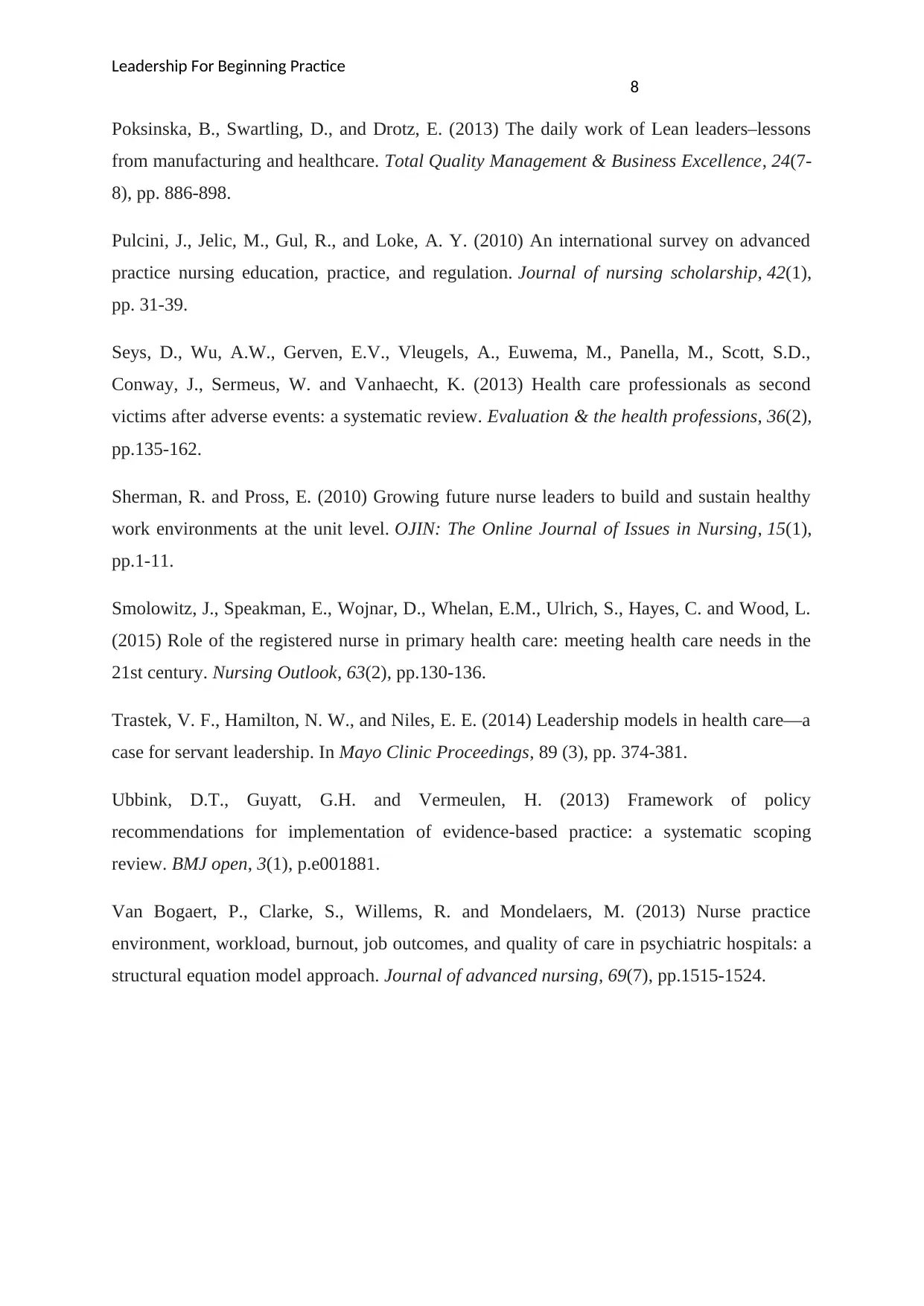
Leadership For Beginning Practice
8
Poksinska, B., Swartling, D., and Drotz, E. (2013) The daily work of Lean leaders–lessons
from manufacturing and healthcare. Total Quality Management & Business Excellence, 24(7-
8), pp. 886-898.
Pulcini, J., Jelic, M., Gul, R., and Loke, A. Y. (2010) An international survey on advanced
practice nursing education, practice, and regulation. Journal of nursing scholarship, 42(1),
pp. 31-39.
Seys, D., Wu, A.W., Gerven, E.V., Vleugels, A., Euwema, M., Panella, M., Scott, S.D.,
Conway, J., Sermeus, W. and Vanhaecht, K. (2013) Health care professionals as second
victims after adverse events: a systematic review. Evaluation & the health professions, 36(2),
pp.135-162.
Sherman, R. and Pross, E. (2010) Growing future nurse leaders to build and sustain healthy
work environments at the unit level. OJIN: The Online Journal of Issues in Nursing, 15(1),
pp.1-11.
Smolowitz, J., Speakman, E., Wojnar, D., Whelan, E.M., Ulrich, S., Hayes, C. and Wood, L.
(2015) Role of the registered nurse in primary health care: meeting health care needs in the
21st century. Nursing Outlook, 63(2), pp.130-136.
Trastek, V. F., Hamilton, N. W., and Niles, E. E. (2014) Leadership models in health care—a
case for servant leadership. In Mayo Clinic Proceedings, 89 (3), pp. 374-381.
Ubbink, D.T., Guyatt, G.H. and Vermeulen, H. (2013) Framework of policy
recommendations for implementation of evidence-based practice: a systematic scoping
review. BMJ open, 3(1), p.e001881.
Van Bogaert, P., Clarke, S., Willems, R. and Mondelaers, M. (2013) Nurse practice
environment, workload, burnout, job outcomes, and quality of care in psychiatric hospitals: a
structural equation model approach. Journal of advanced nursing, 69(7), pp.1515-1524.
8
Poksinska, B., Swartling, D., and Drotz, E. (2013) The daily work of Lean leaders–lessons
from manufacturing and healthcare. Total Quality Management & Business Excellence, 24(7-
8), pp. 886-898.
Pulcini, J., Jelic, M., Gul, R., and Loke, A. Y. (2010) An international survey on advanced
practice nursing education, practice, and regulation. Journal of nursing scholarship, 42(1),
pp. 31-39.
Seys, D., Wu, A.W., Gerven, E.V., Vleugels, A., Euwema, M., Panella, M., Scott, S.D.,
Conway, J., Sermeus, W. and Vanhaecht, K. (2013) Health care professionals as second
victims after adverse events: a systematic review. Evaluation & the health professions, 36(2),
pp.135-162.
Sherman, R. and Pross, E. (2010) Growing future nurse leaders to build and sustain healthy
work environments at the unit level. OJIN: The Online Journal of Issues in Nursing, 15(1),
pp.1-11.
Smolowitz, J., Speakman, E., Wojnar, D., Whelan, E.M., Ulrich, S., Hayes, C. and Wood, L.
(2015) Role of the registered nurse in primary health care: meeting health care needs in the
21st century. Nursing Outlook, 63(2), pp.130-136.
Trastek, V. F., Hamilton, N. W., and Niles, E. E. (2014) Leadership models in health care—a
case for servant leadership. In Mayo Clinic Proceedings, 89 (3), pp. 374-381.
Ubbink, D.T., Guyatt, G.H. and Vermeulen, H. (2013) Framework of policy
recommendations for implementation of evidence-based practice: a systematic scoping
review. BMJ open, 3(1), p.e001881.
Van Bogaert, P., Clarke, S., Willems, R. and Mondelaers, M. (2013) Nurse practice
environment, workload, burnout, job outcomes, and quality of care in psychiatric hospitals: a
structural equation model approach. Journal of advanced nursing, 69(7), pp.1515-1524.
⊘ This is a preview!⊘
Do you want full access?
Subscribe today to unlock all pages.

Trusted by 1+ million students worldwide
1 out of 9
Related Documents
Your All-in-One AI-Powered Toolkit for Academic Success.
+13062052269
info@desklib.com
Available 24*7 on WhatsApp / Email
![[object Object]](/_next/static/media/star-bottom.7253800d.svg)
Unlock your academic potential
Copyright © 2020–2025 A2Z Services. All Rights Reserved. Developed and managed by ZUCOL.





